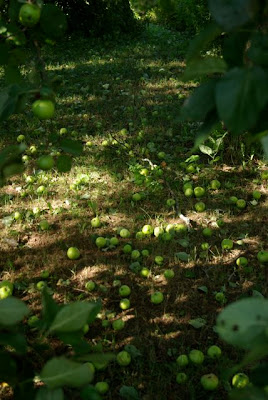Many of you know that Hurricane Irene passed through these parts over the weekend. Much time was spent in preparation, putting away emergency supplies in the house and cleaning up the outdoors. Patio furniture, BBQ, flower pots and other odds and ends were packed up. Although Irene was downgraded to a tropical storm by the time it arrived in PEI it is always better to be safe than sorry.
The positives of this post are that myself and the cats are all okay, the house is still standing with roof intact, the shingles are still attached and the large trees are still upright. I can't ask for anything more.
There were however some casualties. Like this Hydrangea paniculata 'Little Lamb'. The beautiful flowers were beheaded, one after another, lying limp or strewn across the yard.
My Plume Poppy which had reached heights of six feet tall this year just cannot handle wind. I thought it would be safer behind the garage and moved it there in the spring but the wind found it anyway.
 |
| Plume poppy is now laying across the bed covering hostas and hollyhocks |
 |
In the back bed dahlias full of buds that had not yet opened broke off at the base of the plant.
On and on it goes. Shrubs with broken branches, perennials falling over, tomatoes collapsed. It was a hard walk around the garden last night. The apple orchard was the worst though. See the small tree in the photo below, loaded with bright apples. They were several weeks away from ripening.
The photo below is from last night. Only a couple apples remain in the branches.
All blown away. Worse, when I inspected the tree I discovered part of the reason. This tree grows out of an old stump and I suppose the base was not that stable. Closer inspection revealed this.
The tree is broken at the base. I haven't had time to deal with it yet but I suspect the entire tree will need to be removed. Honestly I think the weeds are the only thing holding it up. This is such a shame because this tree was producing really lovely large apples and the tree itself wasn't too large so it was easy to pick. It also creates another problem. I had planned this bed with the idea this tree would create shade for several plants and now I'm going to need to rethink my strategy.
The rest of the orchard did not fare much better. A step under the tree canopy revealed this.
Those are apples that you see. Lots and lots and lots of apples. The ground is covered with them. Every tree shed about half its load and none of these apples are ripe. They are all weeks away from being ready and now they are exceedingly bruised too.
The sight of so many apples on the ground was just downright depressing but I'm also worried about the apples left in the trees. Being tossed around in the wind, knocking against branches and other apples can cause a lot of damage. It really hit me last night how farmers must feel. You work so hard and then lose it all in the single day. I am not reliant on this orchard for money so my loss is only a personal one. But I caught a glimpse of what it must be like to be reliant on mother nature and it wasn't pleasant.
Rather than leave you on that hugely depressing note I'm including a photo of a sunflower. They suffered a few broken branches but remained standing for the most part (although they have a serious lean on them now).
This pretty face belongs to Ruby Eclipse, a cutting sunflower I purchased from Veseys this spring. It's pretty hard to not be lifted up by such beauty.













































